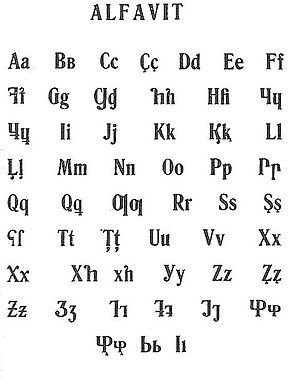| Reversed F | |
|---|---|
| ꟻ | |
 | |
| Usage | |
| Writing system | Latin script |
| Type | alphabetic |
| Language of origin | Abkhaz language, Abaza language, Kabardian language, Adyghe language |
| Phonetic usage | /ʃʷ/, [fʼ] |
| Unicode codepoint | U+A7FB |
| History | |
| Development | 𓌉
|
| Time period | 1920s to 1930s |
| Transliteration equivalents | Ꚗ ꚗ, Шә шә, Фӏ фӏ |
| Other | |
Reversed F (ꟻ ![]() ) is an additional letter of Latin writing used in epigrahic inscriptions to abbreviate the words filia[1] or femina.[2] It was also formerly used in the writing of the Abaza, the Abkhaz, the Adyghe and the Kabardian languages in the 1920s and 1930s.
) is an additional letter of Latin writing used in epigrahic inscriptions to abbreviate the words filia[1] or femina.[2] It was also formerly used in the writing of the Abaza, the Abkhaz, the Adyghe and the Kabardian languages in the 1920s and 1930s.
It is not to be confused with the turned digamma ⟨Ⅎ ⅎ⟩ or with turned f ⟨ɟ⟩.
Utilisation[edit]
-
Epitaph of Fuscus at Arrien-en-Bethmale (Ariège) with reversed F to abbreviate the word filiae.
Reversed F[edit]
Reversed F was formerly used in the writing of the Abaza, the Abkhaz, the Adyghe and in the Kabardian language in the 1920s and 1930s.[3]
-
Abkhaz Latin alphabet of 1930.
-
Abaza Latin alphabet of 1932.
-
Adyghe Latin alphabet of 1927 (page 1)
-
Adyghe Latin alphabet of 1927 (page 2)
Computing codes[edit]
Epigraphic reversed F can be represented with the following Unicode (Latin Extended-D) characters, the lowercase however is not supported by Unicode.
| Preview | ꟻ | |
|---|---|---|
| Unicode name | LATIN EPIGRAPHIC LETTER REVERSED F | |
| Encodings | decimal | hex |
| Unicode | 43003 | U+A7FB |
| UTF-8 | 234 159 187 | EA 9F BB |
| Numeric character reference | ꟻ |
ꟻ |
See also[edit]
References[edit]
- ^ Hübner 1885, p. lxxiv.
- ^ Cagnat 1898, p. 374.
- ^ Joomagueldinov, Pentzlin & Yevlampiev 2012.
Bibliography[edit]
- Cagnat, René (1898). Cours d’épigraphie latine. Paris: Fontemoing.
- Hübner, Emil (1885). Exempla Scripturae Epigraphicae Latinae (in Latin). Berlin.
{{cite book}}: CS1 maint: location missing publisher (link) - Joomagueldinov, Nurlan; Pentzlin, Karl; Yevlampiev, Ilya (18 October 2011). Proposal to encode Latin letters used in the Former Soviet Union (PDF).
- Joomagueldinov, Nurlan; Pentzlin, Karl; Yevlampiev, Ilya (29 January 2012). Revised proposal to encode Latin letters used in the Former Soviet Union (PDF).
- Perry, David J. (2006). Proposal to Add Additional Ancient Roman Characters to UCS (PDF).




